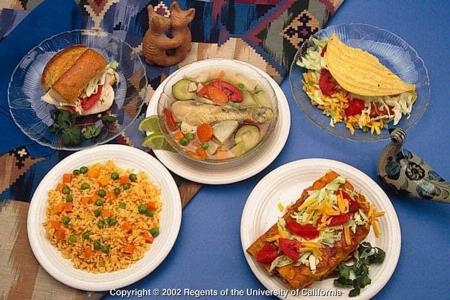Posts Tagged: Mexican
Simple ways to make Latino food more nutritious
In the United States, Latinos account for 15 percent of the population, more than 47 million in all, but you can’t paint their impact on U.S. culture with a broad brush – especially when it comes to food. The Latino population is culturally and ethnically diverse.
Differences between Mexico, Puerto Rico and other Latin American countries stem from 500 years of separate histories, diverse native populations and their customs prior to the arrival of Spanish explorers. In order for nutrition educators to help Latinos maintain a healthy diet, messages should be tailored specifically to the Latino population residing in the particular geographical area.
In California, more than 80 percent of the Latino population is of Mexican descent. The Mexican diet is a blend of pre-Columbian, indigenous Indian, Spanish, French, and recently, American culture. Typically, the Mexican diet is rich in complex carbohydrates, which are provided mainly by corn and corn products, usually tortillas, present at almost every meal, beans, rice and breads. The diet also contains protein from beans, eggs, fish and shellfish, and a variety of meats, mostly pork and poultry. Traditional diets also reflect the geographic regions of Mexico and the availability of local fruits, vegetables, grains and dairy products.
There are simple ways to make traditional Mexican dishes healthier. Following are seven suggestions based on the 2010 American Dietary Guidelines:
- Substitute refried beans with whole black beans or pinto beans. Serve boiled beans instead of refrying them. For flavor, add spices like laurel leaves and other traditional spices.
- For refried beans, substitute lard, butter and shortening with olive oil or vegetable oil. These oils are free of trans fats and contain unsaturated fats, which help prevent cardiovascular disease by inhibiting the buildup of cholesterol in the body.
- Bake your own chips and use whole wheat tortillas to make them crispy and flavorful. This will reduce fat and calorie content.
- Grill or bake instead of frying to reduce the amount of oil you will ingest.
- For toppings, use plain yogurt instead of sour cream. There are some yogurts with the same consistency as sour cream. Add some chipotle, green onion and black olives to give flavor and make it attractive.
- Eat guacamole. Avocado (traditionally known as aguacate or palta) is cholesterol-free and potassium-packed.
- Use more spices – like cumin, peppers, paprika, chili sauces, garlic, cilantro and parsley – instead of salt. Keep salt consumption to less than one teaspoon per day. High salt consumption is linked to increased risk of high blood pressure and kidney disease.
The use of sugar and other caloric sweeteners – such as honey and high-fructose corn syrup – should also be minimized. They contribute to an increased risk of chronic disease, such as cardiovascular diseases and diabetes. The consumption of sugary sodas is very common in the Latino community. Some changes to reduce sugar consumption include:
- Drink water instead of sodas. Add flavor to water by adding mint, parsley, cucumber or lemon slices.
- Drink more aguas frescas; use fruits like pineapple, watermelon, melon, guava, mango. Add some cinnamon for flavor and to reduce the amount of sugar.
- Children should eat cereal without added sugar. Instead they can eat hot cereal and add seasonal fruit like apples, peaches or strawberries.
- Prepare fruits as dessert. Bake apples, serve bananas sprinkled with cinnamon and walnuts, watermelon with chili and lemon, and papaya with lemon.

Examples of traditional Mexican food.
Mexican TV magazine covers Lindcove event
Because of anticipated inclement weather, the producers of the TV program California Country canceled their visit to the UC Lindcove Research and Extension Center's annual citrus tasting on Friday, which this year featured the dedication of two new facilities and the celebration of the facility's 50th anniversary.
After a bitter cold week and a night of heavy rain, the weather on Friday turned mild and dry for the well-attended and notable occasion. And even though the California television magazine wasn't present, the festivities were covered by a TV crew that traveled all the way from Sinaloa, Mexico.Reporter Juan Francisco Sotomayor Valdéz and a photographer from Televisoras Grupo Pacífico gathered information, photos and footage for a 12-minute segment that will be broadcast on a television program that is offered on Sundays at 3:30 p.m Pacific Time. The segment on Lindcove, Sotomayor said, can be viewed on the Internet only while it is broadcast live, probably on Sunday, Dec. 27.
Turning the tables on the visiting reporter, I dusted off my Spanish to ask him a few questions on video about the team's willingness to travel more than 1,000 miles to a citrus research station in the United States. In his response, Sotomayor said they were visiting Lindcove because they understand that UC scientists are leaders in conducting citrus research.
The TV show has also had the opportunity to cover citrus research facilities in Valencia, Spain, and in Brazil. Sotomayor said the program's viewers would be interested in experiences UC researchers have had with the more than 200 varieties of citrus offered to growers in the United States. See the video below:
Sotomayor
